The definition of “world’s fastest car” changed forever on October 10, 2023, when the Bugatti Chiron Super Sport 300+ shattered the previous record by crossing the 300 mph barrier. Speed records that took decades to achieve now fall within months as hypercar manufacturers push the boundaries of aerodynamics, materials science, and powertrain engineering to unprecedented levels. For the dedicated gearheads who’ve followed the evolution of speed from the first land speed records to today’s engineering marvels, these aren’t just cars – they represent the absolute peak of automotive achievement. This deep dive explores the 11 production vehicles that have reset our understanding of what’s possible on four wheels, examining the groundbreaking technology and innovations that make these speeds achievable.
11. Pagani Huayra (Exterior)

The Pagani Huayra showcases Italian craftsmanship with its Mercedes-AMG developed twin-turbocharged 6.0-liter V12 engine, producing 850 horsepower. Engineering excellence shines through the car’s active aerodynamics system, which uses four independently controlled flaps to adjust downforce and drag in real-time. The Huayra’s carbon-titanium chassis represents a breakthrough in automotive materials, weighing just 70 kilograms while exceeding the torsional rigidity of traditional carbon fiber. Automotive enthusiasts particularly appreciate the exposed gear linkage, which transforms each shift into a mechanical symphony through the seven-speed sequential gearbox. The Huayra reaches 238 mph while maintaining the exceptional build quality that has become Pagani’s hallmark.
Pagani Huayra (Interior)

The Huayra’s cabin showcases Italian artistry through its aircraft-inspired design elements and handcrafted leather work. Machined aluminum components throughout the interior create a technical aesthetic, including the exposed gear shifter mechanism and individual climate control outlets. The leather-wrapped carbon fiber seats feature manual adjustment to save weight while maintaining exceptional support and comfort. Pagani’s signature blend of old-world craftsmanship appears in details like the hand-stitched leather dashboard and the machined aluminum instrument cluster, which houses both analog and digital displays.
10. Koenigsegg CCXR (Exterior)
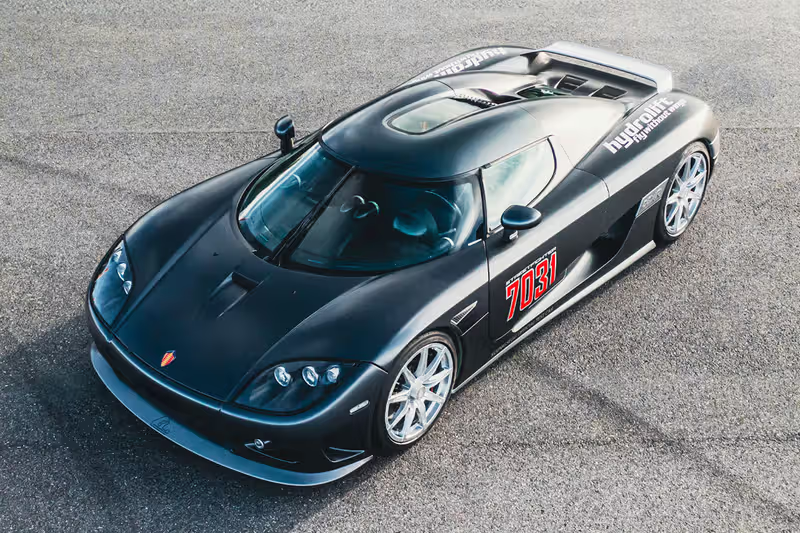
The Koenigsegg CCXR stands as a pioneer in alternative fuel hypercars, with its 4.7-liter twin-supercharged V8 engine capable of running on E85 biofuel to produce 1,018 horsepower. Swedish engineering prowess appears throughout the vehicle, from its proprietary Flex-fuel sensor system to the dihedral synchro-helix door mechanism. The CCXR’s carbon fiber monocoque chassis weighs just 65 kilograms, contributing to the car’s remarkable power-to-weight ratio. This engineering masterpiece accelerates from 0-60 mph in 3.1 seconds and achieves a top speed of 250 mph, marking it as a true performance milestone in automotive history.
Koenigsegg CCXR (Interior)

The CCXR’s interior combines minimalist Scandinavian design with race-inspired functionality. Carbon fiber forms the basis of the cabin structure, with leather and aluminum accents providing luxury touches throughout. The adjustable pedal box allows drivers to find their perfect seating position while maintaining the car’s optimal weight distribution. Koenigsegg designed the digital instrument cluster to provide essential information without distraction, complemented by a center-mounted touchscreen that controls climate and entertainment functions.
9. Aston Martin Valkyrie (Exterior)

The Aston Martin Valkyrie represents Aston Martin’s collaboration with Red Bull Racing, featuring a naturally aspirated 6.5-liter V12 engine that produces 1,160 horsepower at an astonishing 10,500 RPM. Formula One technology appears throughout the car, including a KERS-style hybrid system that provides an additional 160 horsepower boost when needed. The Valkyrie’s underbody Venturi tunnels generate massive downforce without external wings, allowing the car to achieve remarkable stability at its top speed of 250 mph. The interior showcases a Formula One-inspired seating position and a removable steering wheel containing all major controls, making this hypercar a true bridge between road and racing technology.
Aston Martin Valkyrie (Interior)

The Valkyrie’s Formula One-inspired cockpit positions occupants in a feet-up, reclined position similar to race cars. A removable steering wheel contains essential controls and a digital display screen, while additional screens on either side of the dashboard provide rear camera views. The carbon fiber seats integrate directly into the chassis structure, with custom-fitted padding for each owner. Aston Martin eliminated traditional rearview mirrors in favor of camera systems, maximizing aerodynamic efficiency while providing superior visibility.
8. McLaren Speedtail (Exterior)

McLaren’s Speedtail carries forward the legacy of the iconic F1 with its distinctive three-seat configuration and central driving position. The hybrid powertrain combines a twin-turbocharged 4.0-liter V8 with an electric motor to deliver 1,070 horsepower through a seven-speed dual-clutch transmission. Engineering innovations include flexible carbon fiber elements that reshape the rear ailerons under acceleration, electrochromic glass that darkens at the touch of a button, and static wheel covers that minimize turbulence. The Speedtail achieves 250 mph while maintaining McLaren’s signature blend of comfort and performance, helped by an active suspension system that lowers the car by 35mm at high speeds.
McLaren Speedtail (Interior)

The Speedtail’s three-seat configuration places the driver centrally, with two passenger seats set slightly behind. Electrochromic glass in the upper cabin darkens automatically to reduce glare, eliminating the need for sun visors. McLaren developed a unique glass canopy that flows seamlessly into the body, creating an aircraft-like cockpit feeling. The dashboard features hidden-until-lit displays that become visible only when needed, maintaining the cabin’s clean aesthetic at other times.
7. Koenigsegg Regera (Exterior)

The Regera revolutionizes hypercar design with its Direct Drive system, eliminating the traditional gearbox in favor of a single-speed transmission coupled with three electric motors. This innovative powertrain combines a twin-turbo 5.0-liter V8 with the electric motors to produce 1,500 combined horsepower. The hydraulic coupling system allows the Regera to achieve its 251 mph top speed without any gear changes, creating an unprecedented acceleration experience. Advanced features include the world’s first foldable, active rear wing and a battery pack that can fully charge in just 20 minutes, making this hypercar a showcase of Koenigsegg’s engineering creativity.
Koenigsegg Regera (Interior)

The Regera’s cabin exemplifies Scandinavian luxury with its combination of premium leather, carbon fiber, and polished aluminum surfaces. Koenigsegg developed a unique infotainment system featuring a portrait-oriented 9-inch touchscreen that controls everything from performance settings to climate control. The power-adjustable memory seats include heating and cooling functions while maintaining an ultra-lightweight carbon fiber structure. A digital instrument cluster adapts its display based on driving modes, providing different information layouts for street and track use.
6. Rimac Nevera (Exterior)

The Rimac Nevera demonstrates the extraordinary potential of electric hypercars with its four-motor powertrain delivering 1,914 horsepower through an advanced torque vectoring system. Each carbon fiber wheel houses a separate electric motor, allowing unprecedented control over power delivery and handling dynamics. The 120-kWh battery pack integrates directly into the carbon monocoque chassis, enhancing structural rigidity while providing 340 miles of range. This Croatian masterpiece accelerates to 60 mph in 1.85 seconds and reaches 258 mph, proving that electric powertrains have revolutionized the hypercar segment.
Rimac Nevera (Interior)

The Nevera’s interior showcases the future of electric hypercar design with its combination of digital displays and tactile controls. Rimac developed a unique artificial intelligence system that learns driver preferences and adjusts vehicle settings automatically. Three high-resolution screens provide comprehensive vehicle data, with the central screen offering detailed torque vectoring visualization in real-time. The bespoke carbon fiber seats feature integrated cooling systems and position memory, while the entire cabin utilizes sustainably sourced materials.
5. SSC Tuatara (Exterior)

The SSC Tuatara achieves its extraordinary performance through a custom-developed 5.9-liter twin-turbo V8 engine producing 1,750 horsepower on E85 fuel. American engineering expertise shines through the car’s revolutionary aerodynamic design, which maintains a drag coefficient of just 0.279 while generating substantial downforce. SSC developed a proprietary robotic shifting system for the seven-speed transmission, enabling gear changes in less than 100 milliseconds during acceleration runs. The Tuatara’s carbon fiber chassis and body panels help maintain a dry weight of just 2,750 pounds, enabling this Washington-state-built hypercar to achieve speeds of 282.9 mph under verified conditions.
SSC Tuatara (Interior)
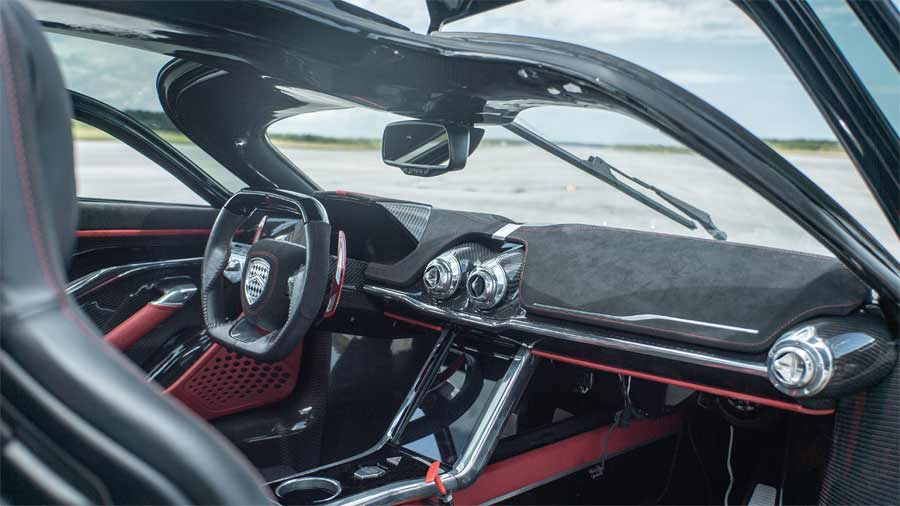
The Tuatara’s cockpit prioritizes driver focus with a fighter jet-inspired design approach. SSC integrated a customizable digital dashboard that changes configuration based on driving modes, displaying essential information through high-resolution screens. The alcantara-wrapped steering wheel includes integrated shift lights and a digital display for critical vehicle data. Carbon fiber sport seats provide exceptional lateral support while maintaining comfort for extended driving sessions.
4. Hennessey Venom F5 (Exterior)

The Hennessey Venom F5 showcases Texas-built performance with its 6.6-liter twin-turbocharged “Fury” V8 engine delivering 1,817 horsepower through a seven-speed single-clutch transmission. Engineering excellence appears in every detail, from the carbon fiber monocoque weighing just 190 pounds to the specially developed Michelin Cup 2 tires rated for extreme speeds. The aerodynamic design maintains stability through careful management of airflow, using active elements to balance downforce and drag at speeds approaching 311 mph. Hennessey’s attention to detail extends to the interior, where exposed carbon fiber and minimal electronics maintain the car’s focus on pure driving performance.
Hennessey Venom F5 (Interior)

The Venom F5’s cabin combines raw performance elements with essential luxury features. Hennessey designed the carbon fiber steering wheel to incorporate vital controls while maintaining a clean, purposeful aesthetic. The fully digital instrument cluster offers multiple display modes, including a dedicated track layout with lap timing capabilities. Leather and Alcantara trim pieces accent the exposed carbon fiber structure, while butterfly doors facilitate entry into the snug cockpit.
3. Bugatti Chiron Super Sport 300+ (Exterior)

The Chiron Super Sport 300+ made history as the first production car to break the 300 mph barrier, achieving 304.77 mph through sophisticated engineering solutions. Bugatti’s quad-turbocharged 8.0-liter W16 engine produces 1,578 horsepower, with power delivery managed through a seven-speed dual-clutch transmission and a specially developed all-wheel-drive system. The elongated longtail body design reduces drag while maintaining stability, complemented by a laser-controlled ride height system that adjusts the car’s attitude at speed. This engineering masterpiece represents the pinnacle of Bugatti’s performance capabilities, combining German precision with French luxury.
Bugatti Chiron Super Sport 300+ (Interior)
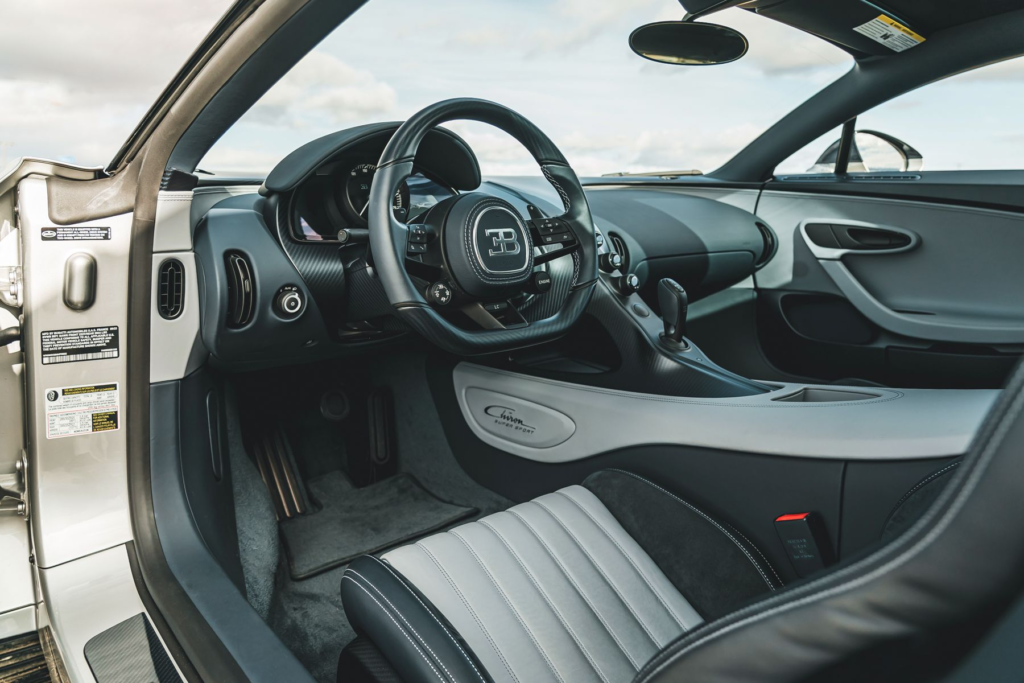
The Chiron Super Sport 300+’s interior represents the pinnacle of automotive luxury and technology. Bugatti crafted the cabin using over 25 separate leather hides and authentic metal components machined from solid blocks of aluminum. The illuminated C-shaped cabin divider houses climate controls and the gear selector while serving as a structural element. Four high-resolution displays provide vehicle information, while the speedometer reaches an unprecedented 500 km/h marking.
2. Bugatti Bolide (Exterior)
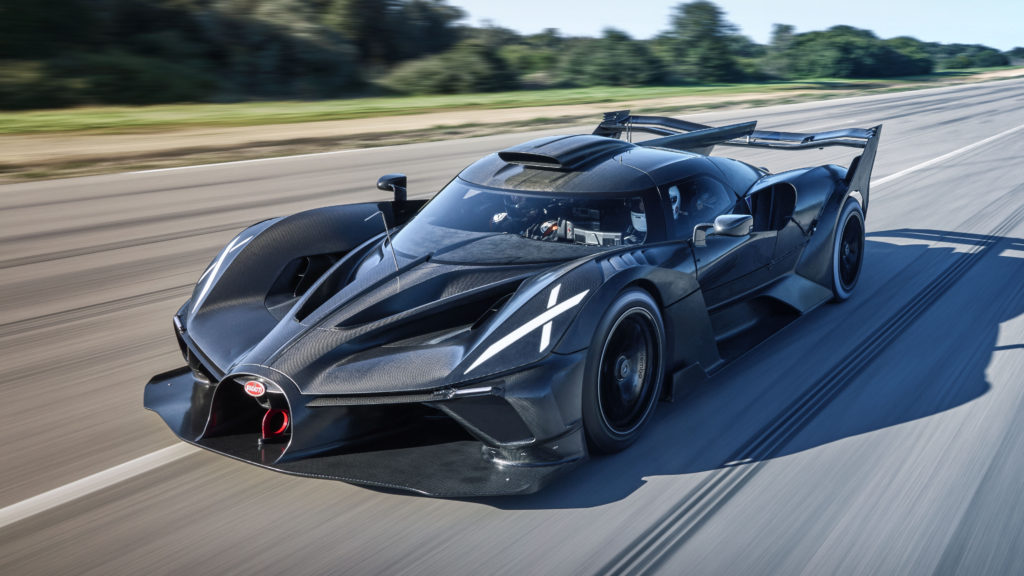
The Bugatti Bolide reimagines the possibilities of track-focused performance, using the legendary W16 engine in its most extreme form to produce 1,824 horsepower. Engineers focused on achieving a power-to-weight ratio of 0.67 kg per horsepower, creating a car that weighs just 2,734 pounds through extensive use of aerospace-grade materials. The morphable outer skin elements actively manage airflow, deploying at specific speeds to maintain optimal downforce while reducing drag. The Bolide achieves theoretical speeds of 310+ mph while generating enough downforce to drive upside down at speeds above 200 mph.
Bugatti Bolide (Interior)

The Bolide’s interior focuses entirely on track performance with a minimalist approach to luxury. Bugatti developed special lightweight racing seats with a six-point harness system approved for FIA competition. The rectangular steering wheel incorporates a digital display screen and essential controls, similar to modern Formula One cars. The exposed carbon fiber cockpit features minimal sound deadening, allowing drivers to experience the full acoustic drama of the W16 engine.
1. Koenigsegg Jesko Absolute (Exterior)

The Jesko Absolute stands as Koenigsegg’s ultimate expression of speed, powered by a twin-turbocharged 5.0-liter V8 engine producing 1,600 horsepower on regular gasoline. The revolutionary Light Speed Transmission can execute gear changes in virtually zero time, using a multi-clutch system that eliminates traditional synchromesh elements. Koenigsegg’s active triplex suspension system maintains optimal ride height and stability at speeds theoretically capable of exceeding 330 mph. The aerodynamic design achieves the lowest drag coefficient of any Koenigsegg ever produced, while still generating sufficient downforce to ensure stability at extreme velocities.
Koenigsegg Jesko Absolute (Interior)
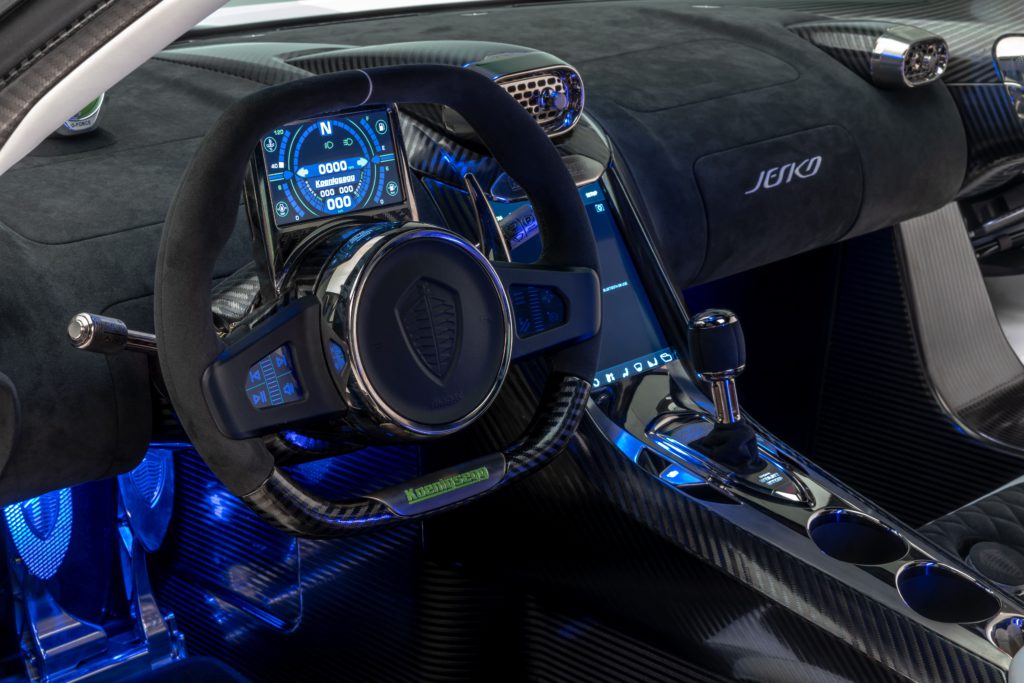
The Jesko Absolute’s interior combines ultimate performance with unexpected practicality. Koenigsegg developed a SmartCluster instrument system that moves with the steering wheel, ensuring perfect visibility in all positions. The carbon fiber seats feature memory foam padding that adapts to each occupant while maintaining minimal weight. A central 9-inch touchscreen controls the climate system and entertainment functions, while smartphone integration enables remote monitoring of vehicle systems. The cabin’s smart-glass roof panels automatically adjust tint levels based on external light conditions.




























